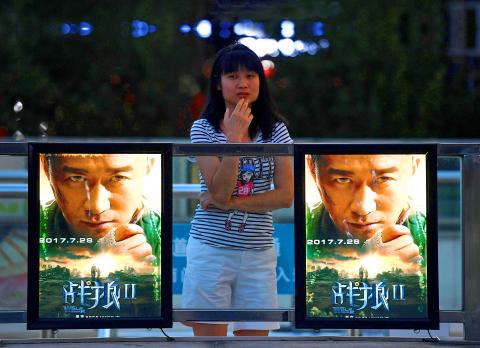When martial arts blockbuster Wolf Warrior 2 earned an astronomical US$854 million in China last year — making it the second-highest grossing film in a single market ever — two things happened. First, the economic might of the Chinese film audience was thrown in the spotlight again; soon, commentators enthused, it would eclipse North America as the biggest in the world. Second, commentators couldn’t stop noticing the film’s nationalistic elements.
One writer combed the film for evidence of China’s geopolitical strategy; the Australian newspaper even called it “Communist propaganda.” (The fact the film climaxes with a morally impeccable ex-People’s Liberation Army soldier stabbing a callous American mercenary in the brain possibly helped this angle along.) Hollywood movies were once regularly accused of “cultural imperialism,” but the rah-rah flag-waving of a Michael Bay film is now so familiar as to be invisible. Yet when China does the same, everybody takes notice.
The response to the film was symptomatic of China’s growing status as global superpower and the cultural influence its cinema is set to wield.

Photo: AFP
ADJUSTING TO CHINA’S FILM SCENE
The money-making potential of China’s film economy is difficult to resist, but for western film industries, entanglement with China means adjusting their product in ways that go beyond the proscriptions of the local censors.
The Australian film industry has already begun calibrating films to work in China — and the results, so far, have been mixed.
We sell the Chinese on the fact that these are Hollywood movies. But secretly they’re Australian. China’s effect on Hollywood is already evident in small ways: superstar cameos in big franchises like Transformers and X-Men, for instance, or the four minutes added to the Chinese edit of Iron Man 3.
The biggest move, though, is co-productions: projects for which international producers officially partner with China’s state film authorities.
So far, these productions have yielded mixed results. The Great Wall — a US-China co-production — met with indifference in China last year and bafflement in the US, where the placement of Matt Damon in the middle of a Chinese medieval fantasy copped accusations of “whitewashing.”
As a model of the future of blockbuster cinema it didn’t seem promising . (The Great Wall targeted American and Chinese audiences but pleased neither, went one headline .)
The Australian industry has been taking a punt on China too. Last year, the Australian Academy of Cinema and Television Arts inaugurated an annual best Asian film award to reflect Australia’s tightening bonds with Asian film industries and the growing impact of the Chinese diaspora on local box office trends (Wolf Warrior 2 was nominated, but lost to India’s Dangal). And November saw the 10-year anniversary of the Australian-Chinese co-production treaty. Eight films have been sanctioned under the treaty, and four have been released.
The latest to reach local screens is Guardians of the Tomb, a cheerfully schlocky creature-feature in which an international cast — including Kelsey Grammer — are menaced by a nest of funnel-web spiders in the booby-trapped tomb of an ancient Chinese king.
Tomb comes from Arclight, an international film sales and financing company that scored a hit in China in 2012 when its Australian-made shark flick Bait 3D earned a surprise US$28 million (it made US$800,000 in Australia).
Since then, Arclight has staked out a position at the intersection of Australia, China and Hollywood, starting up a co-production development initiative, Chinalight, with help from Screen Australia. Arclight’s Australian CEO, Gary Hamilton, sees Australia as a gateway to Hollywood for China. “We don’t describe our movies like Guardians of the Tomb as Australian movies, even though they really are,” he says. “We sell the Chinese on the fact that these are Hollywood movies. But secretly they’re Australian.”
CHINESE OR AUSTRALIAN?
But “secretly Australian” films are a compromised proposition for local stakeholders, who must be satisfied with a film made by the local industry but not really for local viewers, and with little in the way of a local story. Guardians of the Tomb, for instance, had development and production support from Screen Australia, but was conceived largely for the Chinese market. Though it opened on 2,500 screens in China, it debuted on only 12 in Australia. So why channel public funds towards a film that lives or dies overseas?
“[Tomb] was entirely shot in Australia,” Hamilton says, “except for three days in China. It’s Australian writers, an Australian director, lots of Australian actors. I think that’s the trade-off. If you’re making Australian films using Australian taxpayer money just for the Australian market, then it becomes a subsidy, because they’ll never make their money back.
“Most Australian films cannot be sustainable without exporting; and other than a [film like] Lion, most Australian films, if they’re local stories, are not going to travel.”
There’s little in the way of a local story in Guardians of the Tomb.
Prominence is given to Chinese lead Li Bingbing (李冰冰) and Americans Grammer and Kellan Lutz, with Australian Shane Jacobson in support. The most identifiably Australian reference comes in an animated prologue that sees a fleet of ancient Chinese seafarers trading with Indigenous Australians. In one simple gesture, the movie explains away its central conceit — the unlikely presence of funnel-web spiders in the middle of a Chinese desert, while also pointing to a history of cultural exchange in which the film itself takes part.
As a co-production, Guardians of the Tomb is not restricted by China’s import quotas (limited to around 34 foreign films each year) and the foreign backers are entitled to a higher percentage of the Chinese box office takings than they would receive otherwise (42 percent instead of 25 percent).
The film debuted in China on 2,500 cinema screens, which is more screens than Australia has in the whole country. The economic advantage is clear, especially when it puts Australian jobs on the table.
Last year’s Jackie Chan movie Bleeding Steel, not an official co-production, also received Australian support. The Sydney-shot film — the biggest-budget Chinese movie ever filmed in Australia — was attracted to the state by the government’s Made in NSW fund, which touted the 200 production jobs the film would provide.
And yet like The Great Wall, both Bleeding Steel and Guardians of the Tomb found a muted reception at the Chinese box office, with the Chan vehicle earning US$46 million in December and Tomb collecting only US$8 million since it opened in China last month.
CHINESE MOVIEGOERS DOWN UNDER
While the Australian audience for a film like Tomb seems to be a distant consideration for its backers, a small market does exist in Australia for Chinese cinema. Tomb’s Australian release arrives through Asia Releasing, a distribution company that services Chinese communities across the west. The CEO, Milt Barlow, describes an appetite for Chinese movies among the Chinese diaspora that has emerged in the past decade, in step with China’s burgeoning industry.
Wolf Warrior 2, for instance, earned US$1.4 million in its Australian release last year. That might sound relatively small, but it’s not much smaller than the local market for more mainstream Australian fare (in comparison, romcom Ali’s Wedding earned around US$1 million in theatrical release). Total box office for Chinese films in Australia last year was approximately US$5 million. The growing Australian market for Chinese films reflects the growing Chinese-born population — now 2.2 percent of the total, up from 1.2 percent in 2006 .
Even for films like Guardians of the Tomb or Bleeding Steel, with their marginally Australian dressing — a Shane Jacobson here, a throwdown on top of the Sydney Opera House there — distributors target the Chinese diaspora.
“There really isn’t any interest from a western audience,” Barlow says. Chinese students are the key demographic, with the audience clustered mostly in Sydney and Melbourne.
Barlow says Tomb’s small release in Australia reflects its small takings in China. “There’s a long way to go on those co-productions,” he says. “Sometimes they can get stuck in an area where they’re not sure if they’re a Chinese film or a western film.”
Hamilton and Arclight are still looking for the sweet spot in which a project can cater to China but also possess foolproof international appeal. They’re trying to hit it with their next intended Australia-China co-production, Killer 10, a war movie to be directed by Australia’s Phillip Noyce. Despite the martial story, there’ll be none of the contemporary geopolitical resonances of Wolf Warrior 2; Hamilton plans it to be “the first international film to show the Chinese and the Americans fighting arm in arm during World War 2,” and envisions a diverse 10-strong cast of Chinese, American and Australian movie stars.
He professes optimism about the future of co-productions. “All we see are films that haven’t quite worked,” Hamilton says. “The Chinese and the Americans are followers. The minute one [co-production] breaks out as a huge box-office success both in China and the US, everybody is going to follow suit. We’re just seeing the beginning of it.”

June 9 to June 15 A photo of two men riding trendy high-wheel Penny-Farthing bicycles past a Qing Dynasty gate aptly captures the essence of Taipei in 1897 — a newly colonized city on the cusp of great change. The Japanese began making significant modifications to the cityscape in 1899, tearing down Qing-era structures, widening boulevards and installing Western-style infrastructure and buildings. The photographer, Minosuke Imamura, only spent a year in Taiwan as a cartographer for the governor-general’s office, but he left behind a treasure trove of 130 images showing life at the onset of Japanese rule, spanning July 1897 to

In an interview posted online by United Daily News (UDN) on May 26, current Chinese Nationalist Party (KMT) Chairman Eric Chu (朱立倫) was asked about Taichung Mayor Lu Shiow-yen (盧秀燕) replacing him as party chair. Though not yet officially running, by the customs of Taiwan politics, Lu has been signalling she is both running for party chair and to be the party’s 2028 presidential candidate. She told an international media outlet that she was considering a run. She also gave a speech in Keelung on national priorities and foreign affairs. For details, see the May 23 edition of this column,

The Taiwan People’s Party (TPP) on May 18 held a rally in Taichung to mark the anniversary of President William Lai’s (賴清德) inauguration on May 20. The title of the rally could be loosely translated to “May 18 recall fraudulent goods” (518退貨ㄌㄨㄚˋ!). Unlike in English, where the terms are the same, “recall” (退貨) in this context refers to product recalls due to damaged, defective or fraudulent merchandise, not the political recalls (罷免) currently dominating the headlines. I attended the rally to determine if the impression was correct that the TPP under party Chairman Huang Kuo-Chang (黃國昌) had little of a

At Computex 2025, Nvidia CEO Jensen Huang (黃仁勳) urged the government to subsidize AI. “All schools in Taiwan must integrate AI into their curricula,” he declared. A few months earlier, he said, “If I were a student today, I’d immediately start using tools like ChatGPT, Gemini Pro and Grok to learn, write and accelerate my thinking.” Huang sees the AI-bullet train leaving the station. And as one of its drivers, he’s worried about youth not getting on board — bad for their careers, and bad for his workforce. As a semiconductor supply-chain powerhouse and AI hub wannabe, Taiwan is seeing